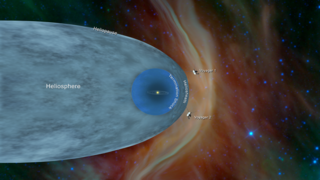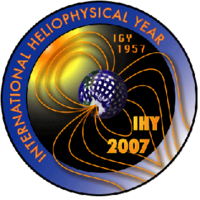
The Voyager program is an American scientific program that employs two interstellar probes, Voyager 1 and Voyager 2. They were launched in 1977 to take advantage of a favorable alignment of the two gas giants Jupiter and Saturn and the ice giants, Uranus and Neptune, to fly near them while collecting data for transmission back to Earth. After launch, the decision was made to send Voyager 2 near Uranus and Neptune to collect data for transmission back to Earth.

The heliosphere is the magnetosphere, astrosphere, and outermost atmospheric layer of the Sun. It takes the shape of a vast, tailed bubble-like region of space. In plasma physics terms, it is the cavity formed by the Sun in the surrounding interstellar medium. The "bubble" of the heliosphere is continuously "inflated" by plasma originating from the Sun, known as the solar wind. Outside the heliosphere, this solar plasma gives way to the interstellar plasma permeating the Milky Way. As part of the interplanetary magnetic field, the heliosphere shields the Solar System from significant amounts of cosmic ionizing radiation; uncharged gamma rays are, however, not affected. Its name was likely coined by Alexander J. Dessler, who is credited with the first use of the word in the scientific literature in 1967. The scientific study of the heliosphere is heliophysics, which includes space weather and space climate.
The Committee on Space Research (COSPAR) was established on October 3, 1958 by the International Council for Scientific Unions (ICSU) and its first chair was Hildegard Korf Kallmann-Bijl. Among COSPAR's objectives are the promotion of scientific research in space on an international level, with emphasis on the free exchange of results, information, and opinions, and providing a forum, open to all scientists, for the discussion of problems that may affect space research. These objectives are achieved through the organization of symposia, publication, and other means. COSPAR has created a number of research programmes on different topics, a few in cooperation with other scientific Unions. The long-term project COSPAR international reference atmosphere started in 1960; since then it has produced several editions of the high-atmosphere code CIRA. The code "IRI" of the URSI-COSPAR working group on the International Reference Ionosphere was first edited in 1978 and is yearly updated.
Solar physics is the branch of astrophysics that specializes in the study of the Sun. It intersects with many disciplines of pure physics and astrophysics.

The following outline is provided as an overview of and topical guide to astronomy:

Interstellar Boundary Explorer is a NASA satellite in Earth orbit that uses energetic neutral atoms (ENAs) to image the interaction region between the Solar System and interstellar space. The mission is part of NASA's Small Explorer program and was launched with a Pegasus-XL launch vehicle on 19 October 2008.
Space physics, also known as space plasma physics, is the study of naturally occurring plasmas within Earth's upper atmosphere and the rest of the Solar System. It includes the topics of aeronomy, aurorae, planetary ionospheres and magnetospheres, radiation belts, and space weather. It also encompasses the discipline of heliophysics, which studies the solar physics of the Sun, its solar wind, the coronal heating problem, solar energetic particles, and the heliosphere.

Heliophysics is the physics of the Sun and its connection with the Solar System. NASA defines heliophysics as "(1) the comprehensive new term for the science of the Sun - Solar System Connection, (2) the exploration, discovery, and understanding of Earth's space environment, and (3) the system science that unites all of the linked phenomena in the region of the cosmos influenced by a star like our Sun."

Energetic Neutral Atom (ENA) imaging is a technology used to create global images of otherwise invisible phenomena in the magnetospheres of planets and throughout the heliosphere.

Space research is scientific study carried out in outer space, and by studying outer space. From the use of space technology to the observable universe, space research is a wide research field. Earth science, materials science, biology, medicine, and physics all apply to the space research environment. The term includes scientific payloads at any altitude from deep space to low Earth orbit, extended to include sounding rocket research in the upper atmosphere, and high-altitude balloons.

The Heliophysics Science Division of the Goddard Space Flight Center (NASA) conducts research on the Sun, its extended Solar System environment, and interactions of Earth, other planets, small bodies, and interstellar gas with the heliosphere. Division research also encompasses geospace—Earth's uppermost atmosphere, the ionosphere, and the magnetosphere—and the changing environmental conditions throughout the coupled heliosphere.

David John McComas is an American space physicist, Vice President for Princeton Plasma Physics Laboratory, and Professor of Astrophysical Sciences and leads the Space Physics at Princeton Group at Princeton University. He had been Assistant Vice President for Space Science and Engineering at the Southwest Research Institute, Adjoint Professor of Physics at the University of Texas at San Antonio (UTSA), and was the founding director of the Center for Space Science and Exploration at Los Alamos National Laboratory. He is noted for his extensive accomplishments in experimental space plasma physics, including leading instruments and missions to study the heliosphere and solar wind: IMAP, IBEX, TWINS, Ulysses/SWOOPS, ACE/SWEPAM, and Parker Solar Probe. He received the National Academy of Science's 2023 Arctowski Medal, European Geosciences Union 2022 Hannes Alfven Medal, SCOSTEP 2022 Distinguished Scientist Award, a NASA Exceptional Public Service Medal in 2015, the 2014 COSPAR Space Science Award, and the American Geophysical Union 1993 Macelwane Medal.

Barbara June Thompson is an American solar physicist. She is a scientist at Goddard Space Flight Center where she researches coronal mass ejections and the dynamics of coronal structures. Thompson was the project scientist for NASA's Solar Dynamics Observatory mission through development and early flight.

In solar physics, heliospheric pickup ions are created when neutral particles inside the heliosphere are ionized by either solar ultraviolet radiation, charge exchange with solar wind protons or electron impact ionization. Pickup ions are generally characterized by their single charge state, a typical velocity that ranges between 0 km/s and twice the solar wind velocity (~800 km/s), a composition that reflects their neutral seed population and their spatial distribution in the heliosphere. The neutral seed population of these ions can either be of interstellar origin or of lunar-, cometary, or inner-source origin. Just after the ionization, the singly charged ions are picked up by the magnetized solar wind plasma and develop strong anisotropic and toroidal velocity distribution functions, which gradually transform into a more isotropic state. After their creation, pickup ions move with the solar wind radially outwards from the Sun.

The Interstellar Mapping and Acceleration Probe(IMAP) is a heliophysics mission that will simultaneously investigate two important and coupled science topics in the heliosphere: the acceleration of energetic particles and interaction of the solar wind with the local interstellar medium. These science topics are coupled because particles accelerated in the inner heliosphere play crucial roles in the outer heliospheric interaction. In 2018, NASA selected a team led by David J. McComas of Princeton University to implement the mission, which is currently planned to launch in late April to late May 2025. IMAP will be a Sun-tracking spin-stabilized satellite in orbit about the Sun–Earth L1 Lagrange point with a science payload of ten instruments. IMAP will also continuously broadcast real-time in-situ data that can be used for space weather prediction.
NASA's Solar Terrestrial Probes program (STP) is a series of missions focused on studying the Sun-Earth system. It is part of NASA's Heliophysics Science Division within the Science Mission Directorate.

Space climate is the long-term variation in solar activity within the heliosphere, including the solar wind, the Interplanetary magnetic field (IMF), and their effects in the near-Earth environment, including the magnetosphere of Earth and the ionosphere, the upper and lower atmosphere, climate, and other related systems. The scientific study of space climate is an interdisciplinary field of space physics, solar physics, heliophysics, and geophysics. It is thus conceptually related to terrestrial climatology, and its effects on the atmosphere of Earth are considered in climate science.

Eckart Marsch is a German theoretical physicist, who worked from 1980 to 2012 at the originally named Max Planck Institute for Aeronomy, from 2004 on named Max Planck Institute for Solar System Research (MPS) in Katlenburg-Lindau on the physics of the solar wind, solar corona and space plasmas and taught at the University of Göttingen.
Polarimeter to Unify the Corona and Heliosphere (PUNCH) is a future mission by NASA to study the unexplored region from the middle of the solar corona out to 1 AU from the Sun. PUNCH will consist of a constellation of four microsatellites that through continuous 3D deep-field imaging, will observe the corona and heliosphere as elements of a single, connected system. The four microsatellites were initially scheduled to be launched in October 2023, but they have since been moved to an April 2025 launch in rideshare with SPHEREx.
Shensuo, formerly Interstellar Express, is a proposed Chinese National Space Administration program designed to explore the heliosphere and interstellar space. The program will feature two or three space probes that will purportedly be launched in 2024 and follow differing trajectories to encounter Jupiter to assist them out of the Solar System. The first probe, IHP-1, will travel toward the nose of the heliosphere, while the second probe, IHP-2, will fly near to the tail, skimming by Neptune and Triton in January 2038. There may be another probe—tentatively IHP-3—which would launch in 2030 to explore to the northern half of the heliosphere. IHP-1 and IHP-2 would be the sixth and seventh spacecraft to leave the Solar System, as well as first non-NASA probes to achieve this status.














